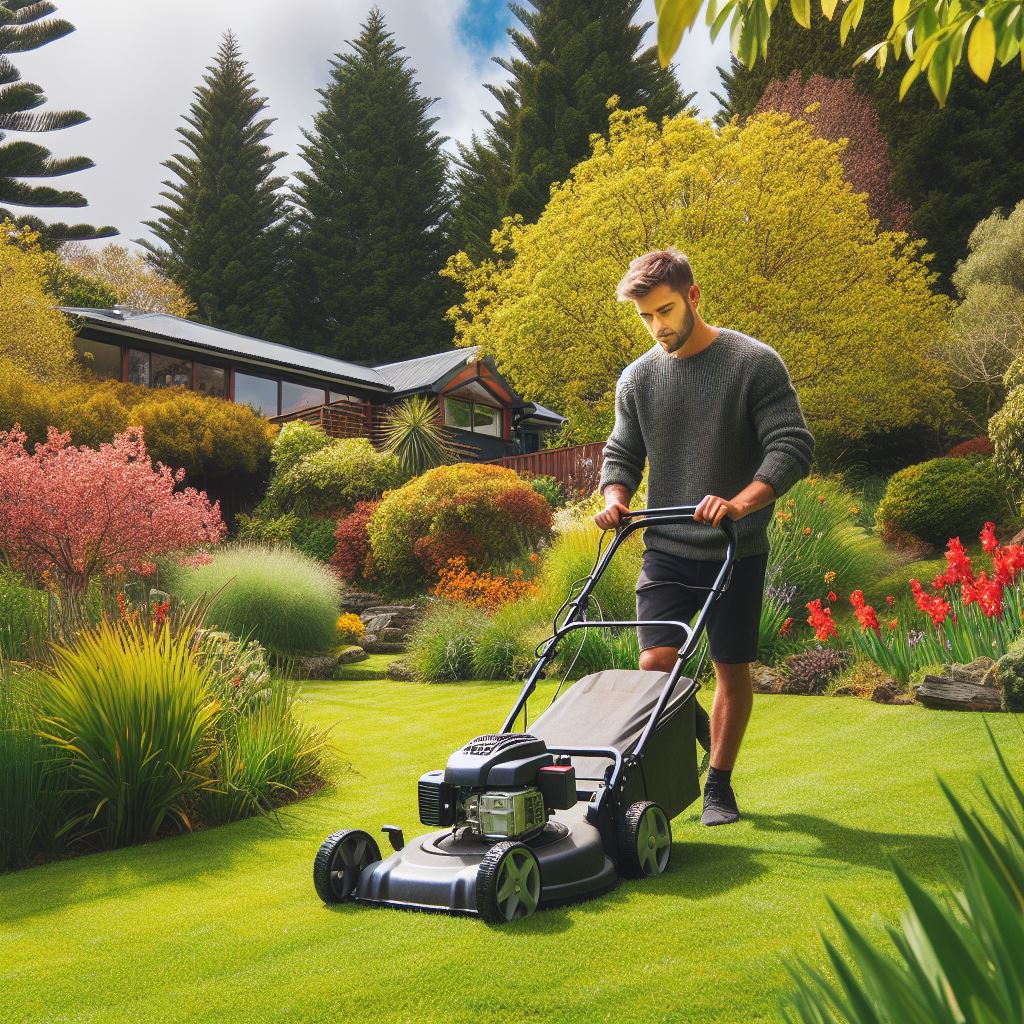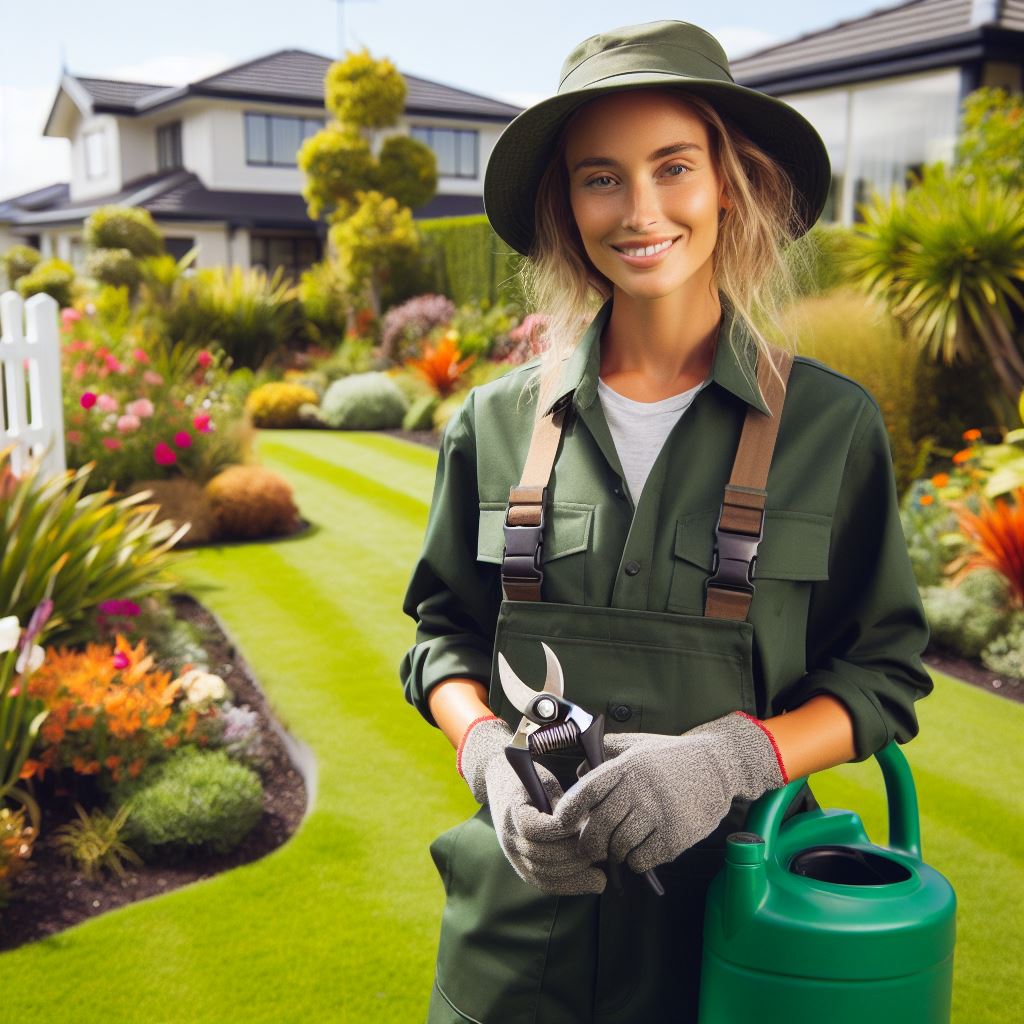Introduction
- Landscaping plays a crucial role in New Zealand for various reasons.
- Pests and plants have a significant impact on the success of landscaping.
- This blog post will provide an overview of the importance of landscaping in New Zealand and the role of pests and plants in it.
Importance of landscaping in New Zealand
Landscaping is of utmost importance in New Zealand, serving both functional and aesthetic purposes.
It enhances the beauty and value of outdoor spaces, providing a peaceful and inviting environment.
Moreover, well-designed landscapes contribute to the overall well-being and mental health of individuals.
Role of pests and plants in landscaping
Pests and plants play a crucial role in shaping the success of landscaping projects.
While plants are the key elements, pests can either enhance or hinder their growth.
Understanding different types of pests and their impact on plants is crucial for maintaining healthy landscapes.
Proper pest management ensures that plants thrive and serve their intended purpose.
Overview of the blog post
This blog post aims to shed light on the importance of landscaping in New Zealand, focusing on its role in creating beautiful outdoor spaces.
Additionally, it will discuss the influence of pests on plant health and provide insights into effective pest management techniques.
By the end of this section, readers will have gained a basic understanding of the significance of landscaping in New Zealand and how pests and plants affect its outcomes.
Subsequent sections will delve deeper into specific pests, plants, and techniques to enhance landscaping productivity.
Stay tuned for valuable insights and practical tips!
Common Pests in NZ Landscaping
Common pests affecting NZ plants
- Aphids
- Caterpillars
- Slugs and snails
- Whiteflies
- Thrips
- Mealybugs
- Scale insects
- Spider mites
- Weevils
- Leafhoppers
Description and characteristics of each pest
- Aphids: small, soft-bodied insects that suck sap from plants, causing curling leaves and stunted growth.
- Caterpillars: larvae of moths and butterflies that eat leaves, causing extensive damage to plants.
- Slugs and snails: feed on leaves and stems, leaving behind slime trails and irregular holes.
- Whiteflies: tiny insects that form colonies on plant leaves, sucking sap and causing leaf yellowing.
- Thrips: slender insects that damage plants by sucking sap and leaving silver or bronze streaks on leaves.
- Mealybugs: small, soft-bodied insects covered in a white, waxy coating, feeding on plant sap.
- Scale insects: immobile pests that attach themselves to plant stems and leaves, causing yellowing and leaf drop.
- Spider mites: tiny arachnids that feed on plant sap, causing yellowing, stippling, and webbing.
- Weevils: beetles that damage plants by feeding on leaves, causing distinctive notches along the leaf margins.
- Leafhoppers: small, flying insects that suck sap from plants, causing leaf curling and stunt growth.
Impact of pests on plants and landscapes
Pests can cause significant damage to plants, impacting their growth, appearance, and overall health.
They can lead to reduced yields, distorted or discolored leaves, stunted growth, and even plant death.
Pests also contribute to the decline of the aesthetic value of landscapes, affecting the beauty and enjoyment of outdoor spaces.
Methods for pest control and prevention
- Cultural practices: Proper plant selection and placement, regular monitoring, and maintaining healthy soil and plants can help prevent pest problems.
- Biological control: Introducing natural predators, such as ladybugs or parasitic wasps, can help control pest populations.
- Mechanical control: Handpicking pests, using traps, or physically removing affected plant parts can reduce pest numbers.
- Chemical control: As a last resort, pesticides can be used, but it is important to follow label instructions and consider their environmental impact.
- Integrated Pest Management (IPM): This approach combines different pest control methods to minimize pesticide use and promote sustainable pest management.
By being aware of common pests, understanding their characteristics, and implementing effective pest control and prevention strategies, NZ landscapers can maintain healthy and thriving plants in their landscapes.
Native vs. Exotic Plants
Native and exotic plants have distinct differences and offer unique benefits and challenges in landscaping.
Here, we explore the advantages of using native plants, as well as the considerations when incorporating exotic plants, and how to create a balanced mix.
Differences between native and exotic plants
- Origin: Native plants naturally occur in a specific region, while exotic plants are from different parts of the world.
- Adaptability: Native plants are well-suited to local climate, soil, and pests, whereas exotic plants may struggle in unfamiliar conditions.
- Biodiversity: Native plants support local ecosystems, providing food and habitat for native insects, birds, and other wildlife.
- Resistance: Exotic plants often lack natural predators, making them invasive and negatively impacting native plant species.
Benefits of using native plants in landscaping
- Low maintenance: Native plants are adapted to local conditions, requiring less water, fertilizer, and pest control.
- Cost-effective: With their resilience, native plants reduce the need for excessive watering, mowing, and pesticide use.
- Biodiversity conservation: Using native plants helps preserve local flora and fauna, promoting a healthy ecosystem.
- Attractiveness: Native plants provide a sense of place and contribute to the beauty and uniqueness of the landscape.
Challenges and considerations when using exotic plants
- Invasive potential: Exotic plants can escape cultivation and invade natural areas, displacing native species.
- Pest problems: Exotic plants may attract non-native pests, which can further disrupt the local ecosystem.
- Water and nutrient requirements: Some exotic plants have higher water and fertilizer needs, increasing maintenance costs.
- Climate suitability: Exotic plants must be carefully selected to ensure they can adapt to the local climate.
Creating a balanced mix of native and exotic plants
- Research and planning: Learn about native plants and select ones that suit your landscape goals and requirements.
- Consider the site conditions: Assess soil type, sun exposure, and drainage to determine which plants will thrive.
- Grouping and layering: Arrange plants with similar water and light needs together to create microclimates.
- Pest management: Monitor exotic plants closely and use integrated pest control methods to prevent invasions.
- Encourage native wildlife: Provide food and shelter for local fauna by including native plants in your design.
- Regular maintenance: Prune, mulch, and water appropriately to ensure the health of both native and exotic plants.
In summary, incorporating native plants in landscaping brings numerous benefits, such as less maintenance, cost savings, biodiversity conservation, and aesthetic appeal.
However, using exotic plants requires careful consideration due to their invasive potential and greater resource needs.
By creating a well-balanced mix and following best practices, you can create a stunning and ecologically responsible landscape.
Read: Women in Electrical Trades: NZ’s Growing Trend
Popular Pest-Resistant Plants in NZ
Overview of pest-resistant plant varieties
- Manuka (Leptospermum scoparium): Known for its pest-repellent essential oils.
- Flax (Phormium tenax): Tough and resistant, commonly used in coastal landscaping.
- Kowhai (Sophora microphylla): Its strong wood discourages pests like possums.
- Hebe (Hebe spp.): Hardy and resistant to attacks from snails and aphids.
- Pohutukawa (Metrosideros excelsa): The iconic Kiwi tree that pests avoid due to its high tannin content.
Descriptions and benefits of each plant
- Manuka: Besides warding off pests, it also has medicinal properties and unique flowers.
- Flax: Its sword-like leaves add architectural interest to gardens, and it can withstand harsh winds and salt spray.
- Kowhai: The vibrant yellow flowers attract native birds, giving your garden a lively touch.
- Hebe: It offers a wide range of colors and can thrive in various soil conditions.
- Pohutukawa: Known as the “New Zealand Christmas tree,” it provides shade and stunning crimson blooms during summer.
Suitable conditions for planting and maintaining pest-resistant plants
- Manuka: Prefers well-drained soil and full sun, suitable for coastal areas.
- Flax: Thrives in sunny spots and can tolerate moist or dry soil.
- Kowhai: Requires a sheltered location and well-drained soil.
- Hebe: Adapts well to different climates, but prefers soil with good drainage.
- Pohutukawa: Needs full sun and well-drained soil, making it ideal for coastal gardens.
Integrating pest-resistant plants into landscape designs
- Create a natural barrier: Plant manuka or flax along fence lines to deter pests.
- Attract beneficial wildlife: Incorporate kowhai and pohutukawa to attract birds, which help control pest populations.
- Add color and texture: Use hebe as decorative borders or in rock gardens for added visual appeal.
- Design for specific conditions: Select plants based on your region’s climate and soil type.
- Combine pest-resistant plants: Incorporate a mix of these varieties to maximize pest control and create a diverse landscape.
By incorporating these popular pest-resistant plants into your NZ landscaping, you can enjoy a beautiful garden while minimizing the need for chemical pest control.
From the vibrant blooms of kowhai and pohutukawa to the hardy nature of flax and hebe, these plants not only repel pests but also enhance the overall aesthetics of your outdoor space.
Remember to consider the specific planting conditions for each variety to ensure their long-term success.
Happy gardening!
Read: Apprenticeships in Electrical Work: NZ Focus

Sustainable Pest Management Practices
Importance of sustainable pest management
- Sustainable pest management is crucial for preserving the health and productivity of gardens and landscapes.
- It helps maintain a harmonious balance between pests, plants, and the environment.
- By practicing sustainable pest management, we can reduce the use of harmful chemicals and minimize their impact on ecosystems.
- It also promotes the conservation of beneficial insects and organisms that contribute to natural pest control.
- Sustainable pest management ensures the long-term viability and sustainability of our landscapes.
Implementation of organic pest control methods
- Organic pest control methods rely on natural products and techniques to manage pests.
- Companion planting is an effective organic method where certain plants are grown together to repel pests or attract beneficial insects.
- Cultural practices such as proper watering, pruning, and maintaining optimal soil conditions can prevent pest infestations.
- Physical barriers like nets, fences, and traps can be used to exclude pests from the garden.
- Homemade remedies like garlic or soap sprays can be used to control specific pests without harming the environment.
Biological pest control options
- Biological pest control involves using living organisms to control pests.
- Predatory insects, such as ladybugs and lacewings, feed on pests like aphids, mites, and caterpillars.
- Parasitoids are another biological control option; they lay eggs on or inside pests, ultimately killing them.
- Nematodes, microscopic worms, can be applied to the soil to control soil-borne pests.
- Bacteria and fungi, like Bt (Bacillus thuringiensis) or Beauveria bassiana, can be used to control specific pests.
Limitations and challenges of sustainable pest management
- Sustainable pest management methods may require more time and effort compared to chemical solutions.
- They may not provide immediate results and may require continuous monitoring and adjustments.
- Some organic pest control methods may not be as effective or have limited effectiveness against certain pests.
- Natural predators and beneficial organisms might not be readily available in all environments.
- Certain pests, like invasive species, may require more intensive management strategies beyond organic methods.
Basically, sustainable pest management is of utmost importance in landscaping.
By implementing organic pest control methods and utilizing biological control options, we can effectively manage pests while minimizing harm to the environment.
However, it is essential to be aware of the limitations and challenges associated with sustainable pest management to develop effective strategies.
With a commitment to sustainability, we can create thriving landscapes that are both beautiful and environmentally friendly.
Read: The Impact of Technology on NZ Electricians
Tips for a Healthy and Pest-Free Landscape
Achieving a healthy and pest-free landscape requires proper maintenance, watering, diversity, and proactive pest control measures.
Regular inspection and maintenance routines
- Inspect your landscape regularly for signs of pest activity or any plant health issues.
- Remove weeds, fallen leaves, and dead plant material as these can attract pests.
- Prune trees and shrubs to maintain their health and prevent overcrowding that creates favorable pest conditions.
- Keep your lawn well-maintained by mowing regularly and aerating it to promote healthy growth.
- Monitor irrigation systems for leaks and ensure proper drainage to avoid waterlogged areas.
- Inspect and repair any cracks or openings in fences, walls, or foundations that pests can use as entry points.
Proper watering and fertilization practices
- Water your plants properly, ensuring deep root penetration and avoiding overwatering.
- Use organic mulch to retain moisture in the soil and suppress weed growth, reducing competition for nutrients.
- Apply fertilizers in appropriate amounts and at the right time to promote healthy plant growth.
- Follow the instructions provided by manufacturers for specific plants and fertilizers.
- Avoid excessive fertilization, as it can attract pests and cause imbalances in the ecosystem.
Creating a diverse environment to deter pests
- Plant a diverse range of native plants in your landscape, as they are more resistant to local pests.
- Avoid monoculture, which can attract specific pests and result in severe infestations.
- Utilize companion planting techniques to create symbiotic relationships among plants, deterring pests naturally.
- Encourage beneficial insects, birds, and bats by providing suitable habitats, such as birdhouses and bat boxes.
- Attract pollinators like bees and butterflies by planting nectar-rich flowers.
Early detection and necessary actions for pest infestations
- Regularly inspect plants for signs of pest infestations, such as distorted leaves, discolored foliage, or sticky residues.
- Identify the pests correctly to determine the most effective control methods, such as physical removal or targeted pesticides.
- Introduce natural predators or parasites that prey on specific pests as part of an integrated pest management strategy.
- Consider organic pest control methods, such as neem oil or insecticidal soaps, to minimize environmental impact.
- Take immediate action when pests are detected to prevent their spread and minimize damage to your landscape.
By following these tips and incorporating them into your landscaping routine, you can create a healthy and pest-free environment for your plants.
Regular maintenance, proper watering and fertilization, a diverse landscape, and proactive pest control will ensure the longevity and beauty of your garden.
Personalized Career Consulting
Unlock your potential with expert career advice tailored to your goals. Get personalized guidance and actionable steps toward your dream career in New Zealand.
Get StartedRead: Residential vs Commercial: NZ Electrician Roles
Conclusion
Let’s revisit and thoroughly summarize the main points and insights discussed across the sections, ensuring a comprehensive understanding of the landscape’s multifaceted dynamics and challenges.
Now, let’s delve into the realm of inspiration and practical guidance, igniting the passion within each reader to embark on a journey of landscape transformation.
We’ll provide in-depth strategies, tips, and resources to cultivate not just any landscape but a thriving oasis, resilient against the onslaught of pests.
We’ll guide readers in choosing plants and practicing sustainable pest management to create biodiverse outdoor havens.
In closing, let’s extend a heartfelt call-to-action, inviting readers to become active participants in our shared quest for landscape excellence.
We urge you to share your own experiences, triumphs, and even setbacks in the realm of landscaping.
Whether it’s a simple tip for deterring pesky critters or a grand vision for transforming entire communities, your insights are invaluable.
Together, let’s cultivate a vibrant community where knowledge flows freely, creativity thrives, and every landscape enthusiast finds a welcoming home for collaboration and growth.
Join us as we embark on this journey towards greener, healthier, and more beautiful landscapes for generations to come.




